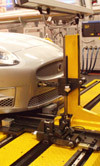Jaguar measurement
 RET was recently invited to Jaguar Land Rover’s PCC – Product Compliance Centre – at its Solihull plant to witness the CO2 emissions testing of the 2009 BTCC race cars. In last month’s Monitor we examined the chassis dynamometer and vehicle restraint system; this month we will focus on the gas analyzing equipment.
RET was recently invited to Jaguar Land Rover’s PCC – Product Compliance Centre – at its Solihull plant to witness the CO2 emissions testing of the 2009 BTCC race cars. In last month’s Monitor we examined the chassis dynamometer and vehicle restraint system; this month we will focus on the gas analyzing equipment.
The PCC consists of two rolling road dynamometers, Cell 1 and Cell 2. Hatton Systems Ltd is responsible for the dynamometer equipment and control systems and HORIBA for the gas analyzing technology.
Vehicles running on carbon-based fuels (gasoline, diesel, LPG, etc) fill their tanks by volume – gallon or litre. It’s generally easier to meter fuel by volume than to weigh it. Vehicle exhaust emissions are regulated and have to be measured. This is done by measuring volumes rather than trying to weigh the gases.
If a carbon fuel burns efficiently carbon dioxide and water are produced. Inefficient combustion is cleaned up by a vehicle’s catalyst; with everything working as expected 99.9% of the fuel is emitted as carbon dioxide. This has become a measure of a vehicles ‘green-ness’, the lower the amount of carbon dioxide emitted, the greener the vehicle is perceived to be.
For the BTCC test program, carbon dioxide emissions are measured over a drive cycle, which has been specified for the purpose. While the vehicle is being driven through the drive cycle, exhaust gases are measured using a special type of flow meter. This is referred to as a Constant Volume Sampling system (CVS). This overcomes the problem with pulsating flows by diluting the exhaust with as much clean air as necessary to stop condensation of the water vapour and to maintain a constant volume at the flow meter.
A sample of the diluting air is taken throughout the test period and analysed for carbon dioxide. The proportion of carbon dioxide found in the sample is applied to the volume of diluted exhaust gas measured by the CVS which gives the volume of carbon dioxide emitted during the test period. Multiplying the volume by the density of carbon dioxide and dividing by the distance travelled during the test period gives a result for carbon dioxide in g/km.
The proportion of carbon dioxide in the sample gas – the sample concentration – is obtained by the use of a fast response and highly accurate emission analyser such as the top of the range HORIBA MEXA-7000. The HORIBA MEXA systems make use of the NIDR (Non-Dispersive Infra-Red) technique. Carbon Dioxide has a strong absorption at a specific wavelength region of the infra-red spectrum. The analyser works by measuring the intensity of this absorption and comparing it that of a known CO2 calibration gas. A sample of the ambient air used to dilute the exhaust gas and a sample of the diluted exhaust itself are piped to the CVS system and stored in special bags made from Tedlar. From here they are sent into the analyser which measures the concentration or amount of carbon dioxide in each bag. The mass of carbon dioxide can then be obtained.
Obtaining the concentration of other emissions components follows the same systematic flow but uses different methods. There is a clear need for very accurate emissions analysis systems in automotive testing and this is one such example.
Written by Tom Sharp.